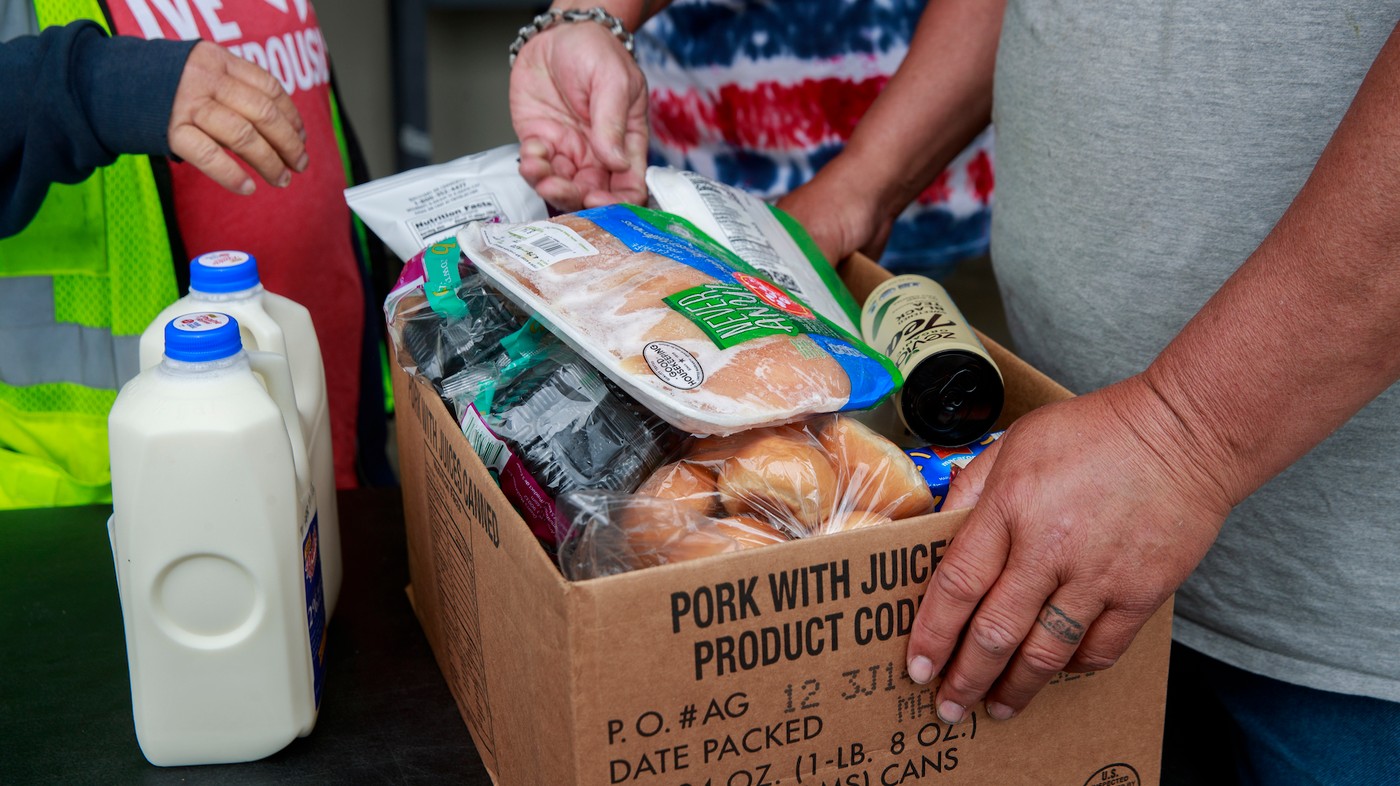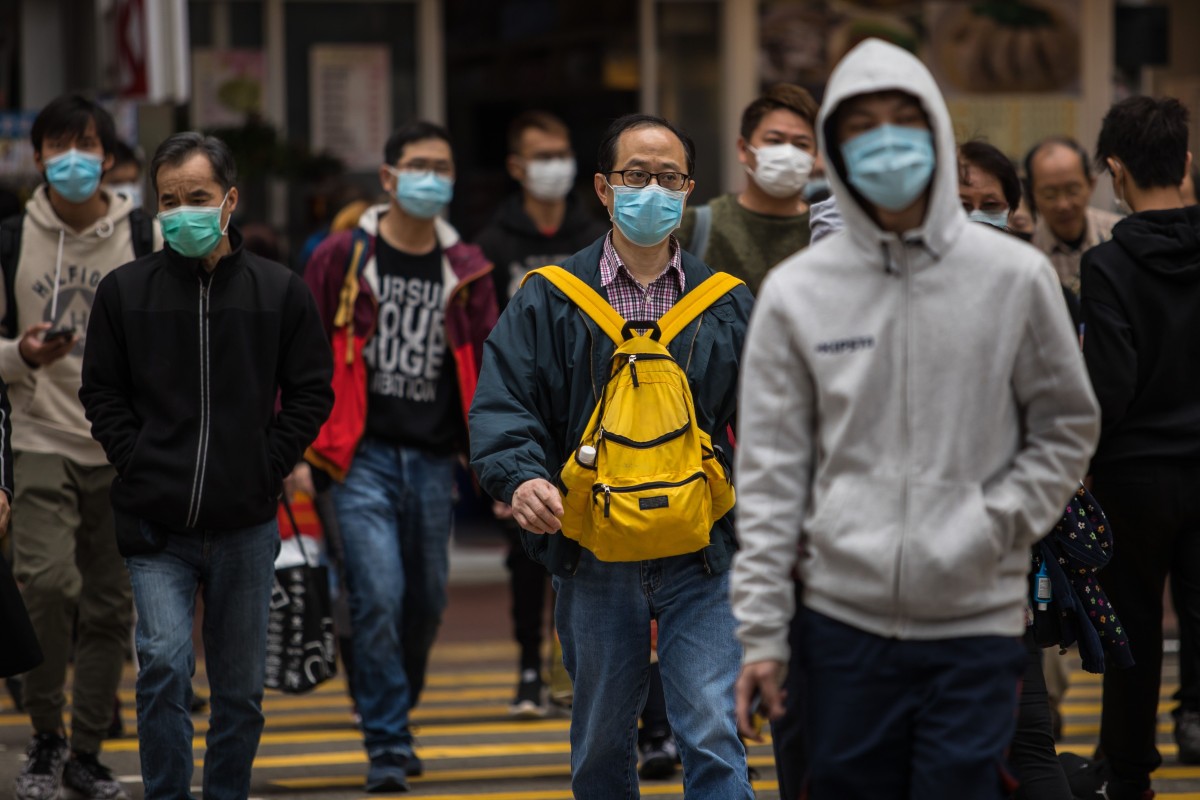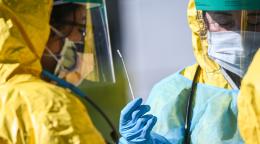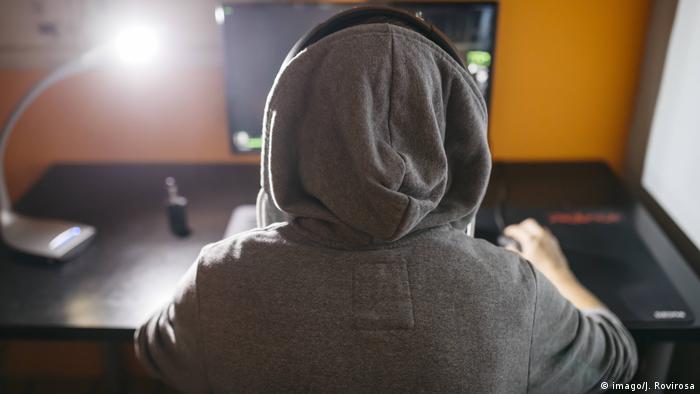Abha Bhattarai WASHINGTON POST APRIL 13,2020


Doug Preszler wasn’t thinking about risk when he took a cashier job at a regional supermarket in eastern Iowa. But five months in, he has found himself at the forefront of a global crisis with little training or protection — save for the pocket-size bottle of hand sanitizer and Ziploc full of disposable gloves he brings from home each day.

© Toni L. Sandys/The Washington Post An employee restocks eggs at a Giant grocery store in Silver Spring, Md.
The 51-year-old has told himself not to live in fear yet concedes he increasingly is. Even the most routine tasks are fraught: Accepting bills and giving change scare him the most, Preszler says. And he has run through so much hand sanitizer that his skin is cracking.
I’ve been way more anxious this week,” he said. “They’ve started telling people, ‘Go to the grocery store as little as possible.’ And yet I’m going there every day.”
Next to health-care providers, no workforce has proved more essential during the novel coronavirus pandemic than the 3 million U.S. grocery store employees who restock shelves and freezers, fill online orders and keep checkout lines moving. Although the public health guidelines are clear — steer clear of others — these workers are putting in longer shifts and taking on bigger workloads. Many report being stressed and scared, especially as their colleagues fall ill to the highly contagious coronavirus that is responsible for more than 21,000 deaths in the United States alone.
Some liken their job to working in a war zone, knowing that the simple act of showing up to work could ultimately kill them. At least 41 grocery workers have died so far. They include a Trader Joe’s employee in New York, a Safeway worker in Seattle, a pair of Walmart associates near Chicago and four Kroger employees in Michigan, as well as employees at meatpacking plants and food processing facilities around the country. Thousands more have tested positive for the virus.
Now workers across the country are staying home or quitting altogether, according to interviews with more than a dozen employees, leaving many markets short-staffed and ill-prepared to deal with demand. That’s complicated the scramble led by Walmart, Kroger and Safeway to fill hundreds of thousands of new jobs. Demand for groceries has doubled in recent weeks, employees say, as Americans avoid restaurants and prepare most of their meals at home.
Job postings for grocery clerks have jumped 60 percent in the past four weeks, according to Julia Pollak, a labor economist for the site ZipRecruiter. Supermarkets are increasingly hard-pressed to find and keep staff. Workers are walking out, going on strike and circulating petitions aimed at getting companies such as Amazon, Trader Joe’s and delivery service Instacart to take additional measures to protect their health.
“The language in job postings has become more desperate,” Pollak said. “Grocery companies are saying there’s an ‘urgent need’ or that they need workers to ‘start immediately.’ It’s becoming more difficult to convince workers to put themselves at risk.”
Chains such as Kroger and Safeway have begun providing masks and gloves. Walmart is checking employees’ temperatures before each shift. And countless large and regional chains have installed plexiglass shields at cash registers and signs encouraging social distancing — the best defense against spreading the coronavirus. But employees say more needs to be done.
“Grocery workers are risking their safety, often for poverty-level wages, so the rest of us can shelter in place,” said John Logan, director of labor and employment studies at San Francisco State University. “The only way the rest of us are able to stay home is because they’re willing to go to work.”
Public health experts generally say nurses, doctors, paramedics and other medical workers have the highest risk of exposure to the coronavirus. But grocery workers also come in close contact with large groups of people, often without meaningful protective gear. They are less likely to have paid sick leave or the financial means to take time off if they feel ill.
The sector’s relatively low pay — grocery cashiers averaged $11.43 an hour in 2018, Labor Department data show — has also become a bigger part of calculus.
More than 1,500 supermarket workers throughout the country have tested positive for the coronavirus, according to the United Food and Commercial Workers International Union, which represents 900,000 grocery employees at chains such as Kroger, Safeway and Giant. Nearly 3,000 members are not working because they are quarantined, hospitalized or awaiting test results, the union said.
“The big picture is workers are frightened,” said Marc Perrone, the union’s president. The labor group, he said, is urging states to categorize grocery workers as first responders to give them higher priority for testing and protective equipment such as masks.
“We believe in our health-care professionals being first, but we also believe that if we’re going to slow the transmission, that we need to start flattening the curve in those areas where grocery employees are literally coming face-to-face with thousands of people,” Perrone said.
Although more than 40 states and the District of Columbia have ordered nonessential businesses to shut their doors in recent weeks, grocery stores are among the few retailers that remain open.
Wando Evans had worked at a Chicago-area Walmart for 15 years when managers sent the 51-year-old home March 23 because he was displaying flu-like symptoms.
Two days later, he was found dead.
Now his brother, Toney Evans, alleges in a wrongful-death lawsuit filed Monday that the world’s largest retailer didn’t provide protective masks and gloves, adequately disinfect the store or keep workers apprised of their colleagues’ illnesses. Another store employee, Phillip Thomas, 48, died four days after Evans.
Walmart spokesman Randy Hargrove said the retailer was “heartbroken” by the deaths. “We take this issue seriously and will respond with the court once we have been served with the complaint,” he said in a statement. The company declined to provide a full count of employees who have tested positive for the virus or died of related complications.
Some employees at a Whole Foods Market in Virginia say they are afraid to go to work.
“It’s like you’re constantly in fight-or-flight mode,” said a worker in her 50s who spoke on the condition of anonymity to protect her job and health insurance. “It’s been scary, it’s been confusing, and there is a palpable fear among everyone who’s still working. It feels like a war zone.”
That fear, she says, picked up last week after a store manager called, texted and emailed late one evening to say that someone at the store had tested positive for the coronavirus. A number of cashiers called in sick the next day, leaving long lines that snaked through the aisles. Although there are signs and stickers at her store encouraging customers to stand six feet apart, not everyone does. (Whole Foods is owned by Amazon, whose founder, Jeff Bezos, owns The Washington Post.)
The store recently installed plexiglass dividers at registers and is offering masks to workers who want them. But, the employee said, there are no limits on how many people can be at the store at one time, and the company has made no specific accommodations for its older or more vulnerable workers.
A spokeswoman for Whole Foods said the company has had “crowd control protocols” at its stores since March 25. The company is also checking workers’ temperatures and providing gloves and masks before each shift, she said.
When the Virginia worker ended her shift that day, she told her manager she wanted time off. She plans to stay home for a couple of weeks, although her children are urging her to quit. Her daughter is helping her update her résumé.
“We’re in new territory, and nobody knows what to do,” she said. “But I also need to keep myself safe.”
Shoppers Food stores in Maryland recently began limiting the number of customers who can shop at one time. It is providing disposable gloves and paying employees an extra $2 an hour. But many workers are still scared. The store hasn’t been able to find masks for its employees, they said, and hasn’t provided them with hand sanitizer in days.
The chain’s parent company, United Natural Foods, did not respond to a request for comment.
“There are things they could have done to better protect us, sooner,” said Amber Stevens, 30, who has been working at the Forestville, Md., store for a dozen years. “It’s a scary feeling to be around so many people and then come home to my family.”
Stevens says she’s lucky to still have a job when much of the economy is upside down. At least 17 million Americans have filed for unemployment benefits since mid-March, and U.S. stock markets have tumbled from the all-time highs set in mid-February. But Stevens worries about passing on the virus to her 9-year-old daughter or 59-year-old mother.
Workers say grocers have done little to assuage their fears. Jasmine Kapralova says she has repeatedly asked her managers at a Trader Joe’s in Seattle for guidance on responding to the virus since late February, after dozens of infections had been confirmed locally. She and her colleagues asked to wear masks to work but were told they would be disciplined if they did, she said.
The 51-year-old has told himself not to live in fear yet concedes he increasingly is. Even the most routine tasks are fraught: Accepting bills and giving change scare him the most, Preszler says. And he has run through so much hand sanitizer that his skin is cracking.
I’ve been way more anxious this week,” he said. “They’ve started telling people, ‘Go to the grocery store as little as possible.’ And yet I’m going there every day.”
Next to health-care providers, no workforce has proved more essential during the novel coronavirus pandemic than the 3 million U.S. grocery store employees who restock shelves and freezers, fill online orders and keep checkout lines moving. Although the public health guidelines are clear — steer clear of others — these workers are putting in longer shifts and taking on bigger workloads. Many report being stressed and scared, especially as their colleagues fall ill to the highly contagious coronavirus that is responsible for more than 21,000 deaths in the United States alone.
Some liken their job to working in a war zone, knowing that the simple act of showing up to work could ultimately kill them. At least 41 grocery workers have died so far. They include a Trader Joe’s employee in New York, a Safeway worker in Seattle, a pair of Walmart associates near Chicago and four Kroger employees in Michigan, as well as employees at meatpacking plants and food processing facilities around the country. Thousands more have tested positive for the virus.
Now workers across the country are staying home or quitting altogether, according to interviews with more than a dozen employees, leaving many markets short-staffed and ill-prepared to deal with demand. That’s complicated the scramble led by Walmart, Kroger and Safeway to fill hundreds of thousands of new jobs. Demand for groceries has doubled in recent weeks, employees say, as Americans avoid restaurants and prepare most of their meals at home.
Job postings for grocery clerks have jumped 60 percent in the past four weeks, according to Julia Pollak, a labor economist for the site ZipRecruiter. Supermarkets are increasingly hard-pressed to find and keep staff. Workers are walking out, going on strike and circulating petitions aimed at getting companies such as Amazon, Trader Joe’s and delivery service Instacart to take additional measures to protect their health.
“The language in job postings has become more desperate,” Pollak said. “Grocery companies are saying there’s an ‘urgent need’ or that they need workers to ‘start immediately.’ It’s becoming more difficult to convince workers to put themselves at risk.”
Chains such as Kroger and Safeway have begun providing masks and gloves. Walmart is checking employees’ temperatures before each shift. And countless large and regional chains have installed plexiglass shields at cash registers and signs encouraging social distancing — the best defense against spreading the coronavirus. But employees say more needs to be done.
“Grocery workers are risking their safety, often for poverty-level wages, so the rest of us can shelter in place,” said John Logan, director of labor and employment studies at San Francisco State University. “The only way the rest of us are able to stay home is because they’re willing to go to work.”
Public health experts generally say nurses, doctors, paramedics and other medical workers have the highest risk of exposure to the coronavirus. But grocery workers also come in close contact with large groups of people, often without meaningful protective gear. They are less likely to have paid sick leave or the financial means to take time off if they feel ill.
The sector’s relatively low pay — grocery cashiers averaged $11.43 an hour in 2018, Labor Department data show — has also become a bigger part of calculus.
More than 1,500 supermarket workers throughout the country have tested positive for the coronavirus, according to the United Food and Commercial Workers International Union, which represents 900,000 grocery employees at chains such as Kroger, Safeway and Giant. Nearly 3,000 members are not working because they are quarantined, hospitalized or awaiting test results, the union said.
“The big picture is workers are frightened,” said Marc Perrone, the union’s president. The labor group, he said, is urging states to categorize grocery workers as first responders to give them higher priority for testing and protective equipment such as masks.
“We believe in our health-care professionals being first, but we also believe that if we’re going to slow the transmission, that we need to start flattening the curve in those areas where grocery employees are literally coming face-to-face with thousands of people,” Perrone said.
Although more than 40 states and the District of Columbia have ordered nonessential businesses to shut their doors in recent weeks, grocery stores are among the few retailers that remain open.
Wando Evans had worked at a Chicago-area Walmart for 15 years when managers sent the 51-year-old home March 23 because he was displaying flu-like symptoms.
Two days later, he was found dead.
Now his brother, Toney Evans, alleges in a wrongful-death lawsuit filed Monday that the world’s largest retailer didn’t provide protective masks and gloves, adequately disinfect the store or keep workers apprised of their colleagues’ illnesses. Another store employee, Phillip Thomas, 48, died four days after Evans.
Walmart spokesman Randy Hargrove said the retailer was “heartbroken” by the deaths. “We take this issue seriously and will respond with the court once we have been served with the complaint,” he said in a statement. The company declined to provide a full count of employees who have tested positive for the virus or died of related complications.
Some employees at a Whole Foods Market in Virginia say they are afraid to go to work.
“It’s like you’re constantly in fight-or-flight mode,” said a worker in her 50s who spoke on the condition of anonymity to protect her job and health insurance. “It’s been scary, it’s been confusing, and there is a palpable fear among everyone who’s still working. It feels like a war zone.”
That fear, she says, picked up last week after a store manager called, texted and emailed late one evening to say that someone at the store had tested positive for the coronavirus. A number of cashiers called in sick the next day, leaving long lines that snaked through the aisles. Although there are signs and stickers at her store encouraging customers to stand six feet apart, not everyone does. (Whole Foods is owned by Amazon, whose founder, Jeff Bezos, owns The Washington Post.)
The store recently installed plexiglass dividers at registers and is offering masks to workers who want them. But, the employee said, there are no limits on how many people can be at the store at one time, and the company has made no specific accommodations for its older or more vulnerable workers.
A spokeswoman for Whole Foods said the company has had “crowd control protocols” at its stores since March 25. The company is also checking workers’ temperatures and providing gloves and masks before each shift, she said.
When the Virginia worker ended her shift that day, she told her manager she wanted time off. She plans to stay home for a couple of weeks, although her children are urging her to quit. Her daughter is helping her update her résumé.
“We’re in new territory, and nobody knows what to do,” she said. “But I also need to keep myself safe.”
Shoppers Food stores in Maryland recently began limiting the number of customers who can shop at one time. It is providing disposable gloves and paying employees an extra $2 an hour. But many workers are still scared. The store hasn’t been able to find masks for its employees, they said, and hasn’t provided them with hand sanitizer in days.
The chain’s parent company, United Natural Foods, did not respond to a request for comment.
“There are things they could have done to better protect us, sooner,” said Amber Stevens, 30, who has been working at the Forestville, Md., store for a dozen years. “It’s a scary feeling to be around so many people and then come home to my family.”
Stevens says she’s lucky to still have a job when much of the economy is upside down. At least 17 million Americans have filed for unemployment benefits since mid-March, and U.S. stock markets have tumbled from the all-time highs set in mid-February. But Stevens worries about passing on the virus to her 9-year-old daughter or 59-year-old mother.
Workers say grocers have done little to assuage their fears. Jasmine Kapralova says she has repeatedly asked her managers at a Trader Joe’s in Seattle for guidance on responding to the virus since late February, after dozens of infections had been confirmed locally. She and her colleagues asked to wear masks to work but were told they would be disciplined if they did, she said.

Shoppers Food employee Amber Stevens, 30, poses outside the store in Forestville, Md. Grocery store workers are putting in longer shifts and taking on bigger workloads. (Jonathan Newton/The Washington Post)
“Anytime we tried to talk to management about this outbreak, they made it clear they did not want us speaking about it,” said Kapralova, 39, who has worked at the company for nearly a decade. “They warned us not to freak each other out and cause panic.”
She and three colleagues, she said, came down with respiratory infections in early March. Kapralova took three weeks off with pay but says she was warned by her manager not to talk about her symptoms — which included a fever, body aches, a cough and difficulty breathing — on social media. She took an extra week off unpaid but is still sick.
Kenya Friend-Daniel, a spokeswoman for Trader Joe’s, confirmed that the company had given Kapralova three weeks of paid leave while she recovers. Managers were concerned, she said, that Kapralova’s social media posts speculating that she had the coronavirus were alarming her colleagues. They asked her to refrain from saying more online because she had not been formally diagnosed, Friend-Daniel said.
Although the grocer initially discouraged workers from wearing masks, Friend-Daniel said it is now providing masks and gloves to all employees to keep up with changing guidelines from the Centers for Disease Control and Prevention.
Kapralova has since asked managers to take her off the store’s schedule, Friend-Daniel said.
“I shouldn’t go in, but I feel pressured to go because I need the money,” Kapralova said. She and her 12-year-old daughter have been living with relatives since they lost their home in a fire five years ago. “I’m scared to death of dying but also of losing my job and not getting paid.”
Elsewhere in Seattle, a longtime Kroger employee says he’s facing a similar decision. At least two colleagues have tested positive for the coronavirus and about 20 more are home sick or awaiting results — although the company has instructed workers not to discuss this with shoppers.
“It scares the hell out of me,” said the employee, who spoke on the condition of anonymity because he fears retribution. “We’re terrified, but what choice we do have? We’re college students or we’re parents trying to raise kids. We need the paychecks.”
Kroger spokeswoman Kristal Howard said the company is communicating “openly and transparently” with its employees and the public. “Our store teams should confirm when there’s been a diagnosed case, sharing how we’ve worked with the health department and the immediate actions taken to sanitize and clean the store,” she said.
The Seattle employee says it never occurred to him that the supermarket job he applied for 13 years ago to support his new wife and infant could one day put his life at risk. He feels vulnerable and scared
“Nobody told us,” he said, “that when the world falls apart, it’s going to fall on our shoulders.
“Anytime we tried to talk to management about this outbreak, they made it clear they did not want us speaking about it,” said Kapralova, 39, who has worked at the company for nearly a decade. “They warned us not to freak each other out and cause panic.”
She and three colleagues, she said, came down with respiratory infections in early March. Kapralova took three weeks off with pay but says she was warned by her manager not to talk about her symptoms — which included a fever, body aches, a cough and difficulty breathing — on social media. She took an extra week off unpaid but is still sick.
Kenya Friend-Daniel, a spokeswoman for Trader Joe’s, confirmed that the company had given Kapralova three weeks of paid leave while she recovers. Managers were concerned, she said, that Kapralova’s social media posts speculating that she had the coronavirus were alarming her colleagues. They asked her to refrain from saying more online because she had not been formally diagnosed, Friend-Daniel said.
Although the grocer initially discouraged workers from wearing masks, Friend-Daniel said it is now providing masks and gloves to all employees to keep up with changing guidelines from the Centers for Disease Control and Prevention.
Kapralova has since asked managers to take her off the store’s schedule, Friend-Daniel said.
“I shouldn’t go in, but I feel pressured to go because I need the money,” Kapralova said. She and her 12-year-old daughter have been living with relatives since they lost their home in a fire five years ago. “I’m scared to death of dying but also of losing my job and not getting paid.”
Elsewhere in Seattle, a longtime Kroger employee says he’s facing a similar decision. At least two colleagues have tested positive for the coronavirus and about 20 more are home sick or awaiting results — although the company has instructed workers not to discuss this with shoppers.
“It scares the hell out of me,” said the employee, who spoke on the condition of anonymity because he fears retribution. “We’re terrified, but what choice we do have? We’re college students or we’re parents trying to raise kids. We need the paychecks.”
Kroger spokeswoman Kristal Howard said the company is communicating “openly and transparently” with its employees and the public. “Our store teams should confirm when there’s been a diagnosed case, sharing how we’ve worked with the health department and the immediate actions taken to sanitize and clean the store,” she said.
The Seattle employee says it never occurred to him that the supermarket job he applied for 13 years ago to support his new wife and infant could one day put his life at risk. He feels vulnerable and scared
“Nobody told us,” he said, “that when the world falls apart, it’s going to fall on our shoulders.








































